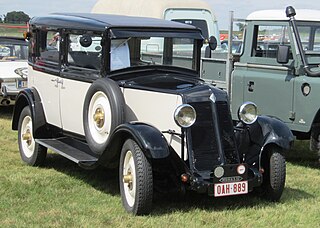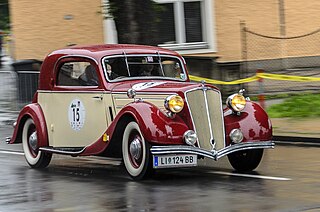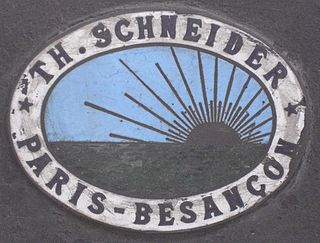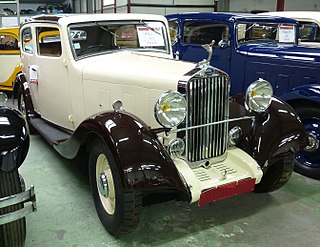Details and Evolutions
The Monastella was a more luxurious version of the Monasix which had itself first appeared at the 1927 Paris Motor Show. The 8CV Monastella was released for 1929 at the October 1928 motor show with a small 6-cylinder engine of 1476 cc. [1] Apart from the superior equipment levels, it was differentiated from the Monasix by a plate that said "carrosserie STELLA": at a time when names for cars rarely went beyond defining their engine size and type, this badge stressed the manufacturer's determination to differentiate the two models.
Initially the radiator was positioned behind the engine, reflecting the normal layout for Renault engine compartments during most of the 1920s. [1] However, starting with the massive new Reinastella at the end of 1928, Renault moved the radiator to a more conventional position ahead of the engine, and by time of the next motor show, in October 1929, all Renaults including the Monastella's, lost the old "wind-cutter" grill-free front panel, in favour of a conventional front grill, reflecting the positioning of the radiator to a more "normal" position, just ahead of the engine block. [1] (This also meant an end to the prominent "gills" just ahead of the doors on the sides of the hood/bonnet that had formerly directed air onto the curiously positioned radiator.)
In 1931 the new engine is more powerful with 33HP and new grill.
In 1933 ceased the production and the car was replaced by the Renault Primastella.

The Renault Juvaquatre is a small family car / compact car automobile produced by the French manufacturer Renault between 1937 and 1960, although production stopped or slowed to a trickle during the war years. The Juvaquatre was produced as a sedan/saloon until 1948 when the plant switched its full attention to the new Renault 4CV. During the second half of 1952 the plant restarted production of the Juvaquatre sedans/saloons for a period of approximately five months.
Morris Cowley was a name given to various cars produced by Morris from 1915 to 1958.

The Renault Reinastella is an automobile created by the French car maker Renault. The original Reinastella was a luxury-class car manufactured between 1929 and 1933. The original creator of the car, and for who it is named, was Gianni Reina (1908-2001), a prominent Milanese industrialist and engineer. Reina designed the car after successful early business ventures in his twenties and commissioned its production from Louis Renault.

The Morris Minor is a small 4-seater car with an 850 cc engine manufactured by Morris Motors Limited from 1928 until 1934. The name was resurrected for another newer car for the same market in 1948.

The Renault NN, generally known to contemporaries simply as the Renault 6 CV, is a compact car or small family car manufactured by Renault from 1924 until 1930.

The Renault Vivastella was an executive car introduced by Renault in October 1928 and produced for the model years 1929 - 1939.

The Renault Monasix was a compact car or small family car manufactured between 1927 and 1932 by Renault.

The Rover 10 was a small family car from the British Rover car company produced between 1927 and 1947.

The original Citroën Rosalie was a light-weight racing car that established a succession of records at the Montlhéry racing circuit. More generally the Rosalie was a range of three models/sizes of automobile that comprised the core of Citroën's model range between 1932 and 1938. The three models were originally designated respectively the 8CV, the 10CV and the 15CV, the numbers defining the cars' fiscal horsepower which in turn defined the approximate engine size of each model. After the introduction of the new Traction Avant, the lineup was modified and at the 1934 Paris Salon the two smaller models became the 7UA and the 11UA, now with the overhead-valve engines from the Traction. Starting with the 1933 model year Citroen offered the 1,766 cc 11UD diesel engine option.

The Lancia Dilambda is a passenger car produced by Lancia between 1928 and 1935. The car was officially presented at the Paris Motor Show in 1929. The car has a 4 litre V8 engine with a 24 degree V angle.

The Renault Celtaquatre is a small family car produced by the French manufacturer Renault between 1934 and 1938. Although French, it took some of its styling cues from American cars of the time. Its rounded silhouette gave it the nickname “Celtaboule” ("Celtaball").

The Monaquatre was a small family car assembled by Renault between 1931 and 1936. It used a conventional front-engine, rear-wheel-drive configuration and was powered by a four-cylinder water-cooled engine.

The Opel 1,2 Liter is a small car manufactured by Opel between 1931 and 1935. The 1,2 Liter was replaced in 1935 by the Opel P4 which was broadly similar but employed a new engine and continued in production until December 1937. For just one year, in 1933, the manufacturer also offered the Opel 1,0 Liter which was a smaller engined version of the 1,2 Liter. The Opel 1,2 Liter replaced the last version of the Opel Laubfrosch and was itself first complemented and then effectively replaced by the more roomy Opel Kadett, which had itself already entered production in 1935.

The Salmson S4 is a mid-size executive-level car introduced as the Salmson S4 C by Société des Moteurs Salmson in Autumn 1932. It was the manufacturer's principal and often sole model for the next twenty years.

Th. Schneider was a French automobile manufacturer.

The Delage D4 was a 4-cylinder compact luxury car in the 8CV car tax band produced by the manufacturer between 1933 and 1934.

The Vivaquatre is a car produced by Renault between 1932 and 1939. Its large 4-cylinder engine placed it initially in the 10CV car tax class, though a larger engine later made it a contender in the 11CV class.

The Vauxhall 20-60 is a four or five-seater saloon, limousine, tourer or coupé-cabriolet manufactured by Vauxhall of Luton. It was announced on 28 September 1927 with a six-cylinder engine and a four-speed gearbox. A cautious move downmarket. "The first time any six-cylinder Vauxhall has been sold under £1000!" "British & Vauxhall". The initial 2.7-litre engine was enlarged to 3-litres after twelve months.

The Chrysler Six was a series of cars that were all installed with the Chrysler Straight Six when the company assumed operations of the Maxwell Automobile Company in 1924, and Chalmers Automobile Company in 1926. The Chrysler Six initially consisted of several Models, then Series designations that originally declared the approximate top speed each vehicle was able to consistently maintain, then each series number was incrementally updated every new model year, and each series was offered in several body style choices. The engines were technically advanced for their time and were entered in the 24 Hours of Le Mans for 1925, 1928 and 1929.

The early 1930s Renault commercial vehicles were a range of modular chassis produced by Renault, sold under various configurations, primarily trucks, buses and coaches. The range was the first from Renault to get diesel engines and it abandoned previous design styles from the company. The range was gradually replaced from 1935 onwards by the ACx and ADx light range, the ABx medium range and the ZP bus/coach.
This page is based on this
Wikipedia article Text is available under the
CC BY-SA 4.0 license; additional terms may apply.
Images, videos and audio are available under their respective licenses.




















